If you have the idea of having a further understanding of China’s history and culture, don’t miss this 15-day China Silk Road Tour from Hong Kong. Accompanied by our professional guide, you will have lots of places to visit from Hong Kong. For example, you will go to Lantau Island, the biggest island in Hong Kong. If you are curious about how to reach Lantau Island from Hong Kong Island and whether it’s worth a visit, this tour can let you have the answer, and I’m sure it will be an unforgettable experience to take Ngong Ping 360 Cable Car to reach the top of Lantau Island. After getting to Shenzhen from Hong Kong, you will start the trip on the mainland. You will visit many historical sites and enjoy Chinese classical architectures and unique buildings of ethnic minorities. The places you will visit are related to the Silk Road, which will help you know about the flourishing brought by the Silk Road in both ancient and modern times. Book the tour now and find out more about China on this tour from Hong Kong!

Welcome to Hong Kong! Hong Kong is an international metropolis with a total area of 1106.66 square kilometers and a population of over 7.47 million. Its full name is Hong Kong Special Administrative Region of the People’s Republic of China. It is the third-largest financial center in the world and is called the Pearl of the Orient and the Paradise of Food and Shopping. You can not only see beautiful natural scenery but also enjoy various pleasures brought by the prosperous economy in Hong Kong. So please enjoy yourself here and explore the tour from Hong Kong. Our guide will hold your name sign and wait for you at the airport and then transfer you to the hotel. Your guide will tell you some information about the tour and interesting stories about Hong Kong. You will receive excellent service during this tour. Have a nice journey!
In the morning, you will first visit Victoria Peak. As the highest mountain on Hong Kong Island, with 554 meters above sea level, it will provide you with the best bird’s eye view of Hong Kong and Victoria Harbour. You can easily reach the summit by Peak Tram which has been in service since 1988. The tram climbs from an altitude of 28 meters to 396 meters along a slope. After arriving at the terminal of the tram, Peak Tower will come into view. There is global cuisine, all kinds of stores, and entertainment facilities. It is also the location of Madame Tussaud’s, where you can see wax figures of celebrities and movie stars from around the world, such as Jackie Chan and David Beckham. Tickets to Madame Tussaud’s are not included, you can buy tickets on-site if you are interested.
Then you will go to Repulse Bay. The crescent-shaped bay is known as the best bay in the world and Oriental Hawaii. Many Hong Kong people and tourists come here to have a relax, especially in summer. You can swim, walk on the sandy beach, and sit in the shade of palm trees. With great scenery, perfect facilities, and seaside shopping centers, Repulse Bay becomes a place that can meet all people’s demands. Therefore, it is also one of the most luxurious residential areas in Hong Kong. On the slope of the bay, a lot of villas and mansions are located there. At the southeast end of Repulse Bay, there is a building with Chinese classical style called Zhenhai Tower. Many auspicious statues can be seen there. For example, facing the sea stand two statues, Tin Hau and Avalokitesvara, which are more than 10 meters high.
The last stop of our tour today is Stanley Market. It is located in the southeast of Hong Kong Island and is an open-air market. These stores sell souvenirs and a wide variety of traditional Chinese handicrafts, such as Chinese calligraphy and painting, silk, clothing, and jade ware, and so on. You can purchase your favorite souvenirs and take them back as gifts for your family and friends. Particularly, you can enjoy the fun of bargaining here. In addition, the Stanley Artsmart is held at Stanley Square on the second weekend of every month. If you are interested in arts, you can appreciate the artists’ works on display. The half-day tour is over. Hope you have an unforgettable experience. Then you will be transferred to the hotel and have a rest.
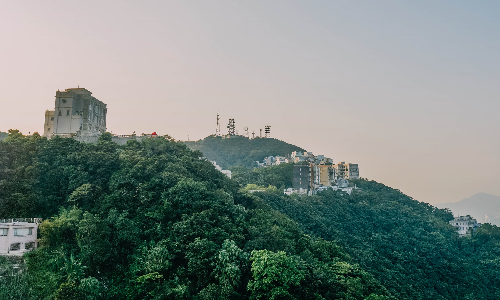
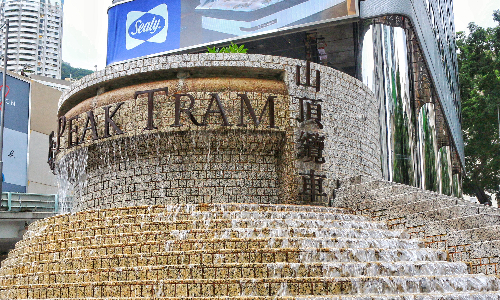
This morning, we will drive southwest for about 30 minutes to Tung Chung Cable Car Terminal, about 30 kilometers away from the center of Hong Kong. Then you will take Ngong Ping 360 Cable Car to the top of Lantau Island which covers an area of 147 square kilometers and is the largest island in Hong Kong. In the past, Lantau Island was sparsely populated and a lot of lands were undeveloped due to its inconvenient transportation and remote location. With the completion of the Hong Kong International Airport and the Tsing Ma Bridge, it is connected to the urban areas of Hong Kong.
Ngong Ping 360 Cable Car is 5.7 kilometers in length and it takes about 25 minutes to reach the top. In the comfortable cable car, you will see the natural landscape of Lantau Island, the Hong Kong International Airport, and a panoramic view of the Ngong Ping mountain. It should be noted that there are two kinds of cable cars, Standard Cabin and Crystal Cabin, and we will arrange the former by default. Unlike Standard Cabin, Crystal Cabin has a transparent bottom and you will feel mountains and rivers under your feet when the cable car is running, so it’s perfect for those who like to try something exciting. Of course, it is not recommended for people with acrophobia. So, if you want to change it to Crystal Cabin, please contact us and our staff will be at your service at any time.
After reaching the top of the mountain, you will visit the Big Buddha, the biggest bronze statue of Buddha in the world and it took 12 years to build the Big Buddha. The Big Buddha is 26.4 meters in height and 250 tons in weight. There is a three-story exhibition hall inside the base of the Big Buddha. The three-story hall is connected by a circular staircase. In the middle of the hall, there is a big bell on which figures of the Buddha and Buddhist scriptures are carved. The computer-controlled bell strikes every seven minutes and 108 times a day, which means to “relieve 108 annoyances”. The Big Buddha is directly opposite Po Lin Monastery, your next stop. Inside it, you can appreciate the palace-style Main Hall, the Tian Wang Hall, and other halls. In the main hall, three bronze statues of Buddha are enshrined there, representing respectively the past, present, and future lives. After visiting the two places, I believe that you can deal with frustrations and sufferings in your life with a sense of peace.
After lunch, you will be taken to the Ngong Ping Village that was opened in June 2006. It is close to the Big Buddha and covers an area of 1.34 hectares. Walking into the Ngong Ping Village, you will see not only various restaurants which provide a wide selection of cuisines and cater to the needs of visitors from home and abroad, but also shops, entertainment facilities, as well as tourist attractions. If lucky, you might even see street performances here, such as kung fu, juggling, and Cantonese opera. Besides, the Bodhi Wishing Pavilion is popular with tourists. You can buy a wishing wooden card, write your wishes and then hang it in the pavilion. Hope your wishes come true! When you get to the end of Ngong Ping Village, you will catch sight of a fortune cat and you can take photos with it. After the visit, your guide will take you to the hotel. You can have a rest or take a walk around by yourself.
Option: Tai O Fishing Village, located in the west of Lantau Island, is the most famous fishing village in Hong Kong and known as the Venice of Hong Kong. As a routine port on China’s ancient “Maritime Silk Road”, Tai O Fishing Village is a nice place to go in our China Silk Road Tour from Hong Kong. After leaving Ngong Ping Village, you will take public transport to Tai O Fishing Village. Entering the fishing village, you will feel like being in Hong Kong in the 1930s and 1940s. Traditional stilt houses, which are built over rivers, are closely connected. The street is lined with shops and on both sides of the road are small stalls selling dried seafood and fruit. You can also choose to enjoy the beautiful scenery by sampan. Villagers will drive it to guide you through the waterway for an excursion. One of the highlights of Tai O Fishing Village is the Chinese White Dolphin (pink dolphin). Chinese White Dolphins have been spotted in the waters around the Tai O fishing village since the 17th century. In order to have a look at the Chinese white dolphins, many visitors would try their luck to take the journey on the water.
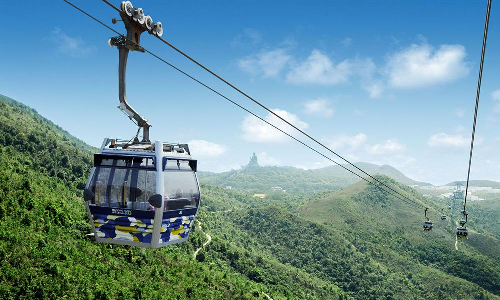
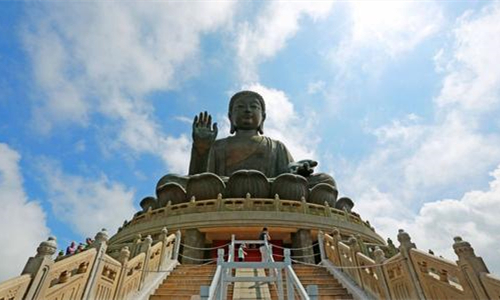
 Shenzhen
Shenzhen Today you will be transferred to Hong Kong West Kowloon Railway Station and take the estimated train G636 09:22/09:46 to Shenzhen. You can have a rest on the train or enjoy the scenery along the way. Shenzhen, also known as Pengcheng, is a prefecture-level city of Guangdong Province. It covers an area of 1,997.47 square kilometers and has a population of over 17,560,000. In 1980, Shenzhen became China’s first special economic zone. With the support of national policies, it has developed from a small border town to a modern international city. As an important part of both the ancient Maritime Silk Road and the Belt and Road Initiative, Shenzhen is your second stop in the Silk Road tour started from Hong Kong.
In the morning, your guide will wait for you at the railway station and then take you to visit the Shenzhen Museum (closed each Monday), founded in 1981. After two years of upgrading, Shenzhen Museum reopened in 2020 with a completely new look. The whole hall is full of a sense of modern art and technology and you can see three white capsule elevators in unique shapes. There is a World Wildlife Specimen Exhibition on the first floor of the exhibition hall. With many lifelike specimens, you would feel like walking into a wildlife park. If you like animals, it will be a must-see. On the second floor, you will enjoy the exhibitions of ancient Shenzhen, modern Shenzhen, and Shenzhen folk culture, which helps you have a good understanding of the history, development, and folk culture of Shenzhen. Then the exhibitions on the third floor introduce you to the history of Shenzhen’s reform and opening-up.
After lunch, you will go to the Splendid China Folk Village. The idea of building it was inspired by the Madurodam (a theme park of miniature landscapes and buildings) in Holland. The Splendid China Folk Village is a theme park with an area of 300,000 square meters that gathers folk arts, customs, and buildings of ethnic groups. The 25 ethnic villages are mainly built on a 1:15 scale, where you can see the bamboo houses of the Dai nationality, the mushroom-shaped houses of the Hani nationality, the Mongolian yurts, and other ethnic minority residential buildings. If lucky, you can also experience the Water-Sprinkling Festival and the Torch Festival and participate in ethnic singing and dancing performances. In addition, you can watch the production of ethnic handicrafts and taste ethnic snacks. Then your local guide will drive you to the hotel.
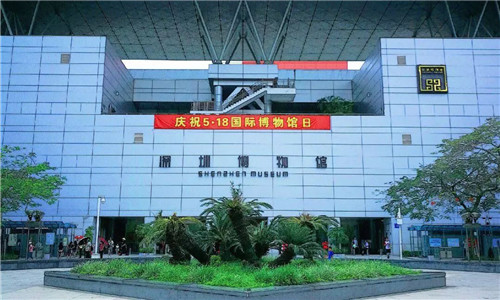
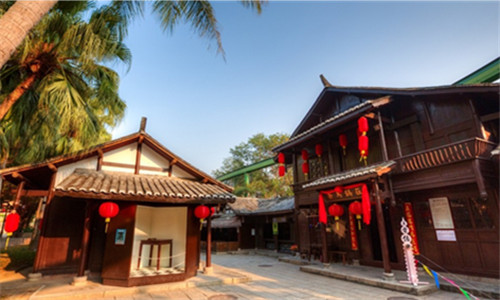
 Lanzhou
Lanzhou After breakfast, you will be transferred to Shenzhen Airport and then take the estimated flight HU7763 15:15/18:25 to Lanzhou. Your local guide will be holding your name sign and waiting for you at the airport. Later, you will be taken to the hotel in Lanzhou and your guide will make a brief introduction of Lanzhou for you on the way.
Lanzhou, located in the northwest of China, is the provincial capital of Gansu and also an important city along the Silk Road Economic Belt. It is 13,100 square kilometers in area and has a population of more than 4.3 million. As early as 5,000 years ago in the Neolithic Age, the ancestors of the Chinese nation lived here. The ancient Silk Road has also left lots of places of interest and splendid culture, which attract a great number of visitors from home and abroad. Besides, Lanzhou is the only city that the Yellow River passes through and the urban area is surrounded by mountains and rivers, forming a unique urban landscape.
 Jiayuguan
Jiayuguan Today you will drive southwest for about 3 hours to the Bingling Cave-Temple, about 130 kilometers away from the center of Lanzhou. The Bingling Cave-Temple, formally built in the Western Qin Dynasty (385-431), has a history of more than 1,600 years. It’s a famous cave-temple in China, where you can appreciate stone statues, pagodas, and frescoes. On the 60-meter-high cliff, craftsmen hung on ropes and built plenty of Buddhist caves in the past. Nowadays, there are 183 grottoes, 776 statues, and over 900 square meters of frescoes. Among the 183 grottoes, No. 169, a natural cave, is the largest one and preserves the statues and frescoes of the Western Qin Dynasty.
In the afternoon, you will be driven to the Lanzhou Railway Station and take the estimated bullet train D2751 14:59/20:54 to Jiayuguan, located in the northwest of China. Jiayuguan covers a total area of 2,935 square kilometers and has a population of over 300 thousand. It is named after the Jiayu Pass, the western end of the Ming Great Wall. In the Ming (1368-1644) and Qing (1636-1912) Dynasties, it was an important place for merchants and ambassadors to gather. Soldiers and travelers also held singing and dancing activities here. When you arrive, your guide will be waiting for you at the railway station and then take you to the hotel in Jiayuguan.
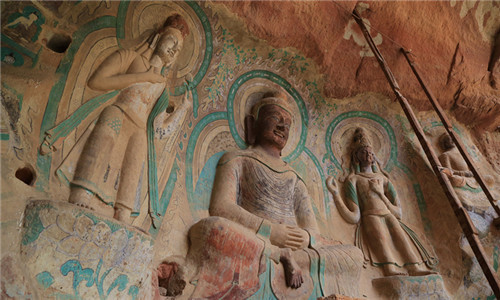
 Dunhuang
Dunhuang This morning we will drive for about 12 minutes to visit the Jiayu Pass, situated 5 kilometers west of Jiayuguan. Jiayu Pass was built in 1372, the Hongwu period of the Ming Dynasty, and it’s about 60 kilometers long. It’s the westernmost end of the Ming Great Wall and a transportation hub on the ancient Silk Road, so you might even see the traces left by the carriages in the past. On the west gate tower of the Jiayu Pass, you will find one brick lying alone on the cornice and there is a legend about this brick. In the Ming Dynasty, a workman named Yi Kaizhan was good at arithmetic and he said that it would need 99,999 bricks to build the Jiayu Pass. The supervisor told him if his calculation was wrong, all workmen would be punished. When the project was completed, one brick was left and the supervisor was ready to punish them. Nevertheless, Yi Kaizhan was in no hurry and said that the brick was purposely left there by the god, which was used to steady the tower. And if the brick was moved, the gate tower would collapse. Since then, the brick has been kept there.
After lunch, you will go to the Jiayuguan Railway Station and take the estimated bullet train D2749 14:29/17:20 to Dunhuang. After arriving in Dunhuang, your private guide will take you to the hotel. Dunhuang, located at the intersection of Gansu, Qinghai, and Xinjiang Provinces, has an area of 31,200 square kilometers and a population of over 190 thousand. Dunhuang was established as a frontier fortress in the Han Dynasty (202BC-220AD) and it was a gateway to the west. It is a city on the Silk Road and famous for its grottoes and murals. In Dunhuang, you can not only visit many tourist attractions but taste local delicacies and all kinds of sweet fruits.

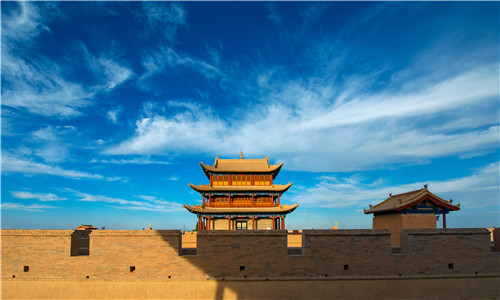
Today you will first visit the Mogao Grottoes, 25 kilometers southeast of the center of Dunhuang. It takes you about half an hour to drive there. The Mogao Grottoes, also known as the Thousand Buddha Caves, has 735 surviving caves, 45,000 square meters of murals, and 2,415 clay sculptures. The largest cave is more than 200 square meters and the smallest one is less than 1 square kilometer. Colorful murals show various stories in Buddhist scriptures, natural landscapes, architectural paintings, flying Buddha, floral patterns, and so on. Please note that these murals in Mogao Grottoes are greatly precious so it is forbidden for tourists to take photos with flashing lights.
After lunch, you will drive northwest for around 30 minutes to the Crescent Spring and Echoing Sand Dune, about 28 kilometers away from the Mogao Grottoes. The crescent-shaped spring is nearly 100 meters long from north to south and 25 meters wide from east to west, and the deepest point of the water is about 5 meters. The Crescent Spring is surrounded by the Echoing Sand Dune but has never been buried by sand, forming a spectacular sight. Being a city dweller, you might be very curious about deserts and camels. You can try the camel ride there at your own expense and enjoy the magnificent scenery along the way and experience the passion of desert exploration. I believe it will make a deep impression on you. Today your trip is coming to an end and your guide will take you back to the hotel.
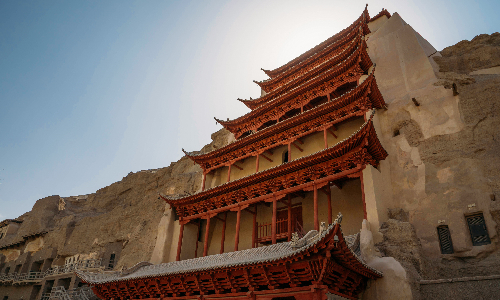
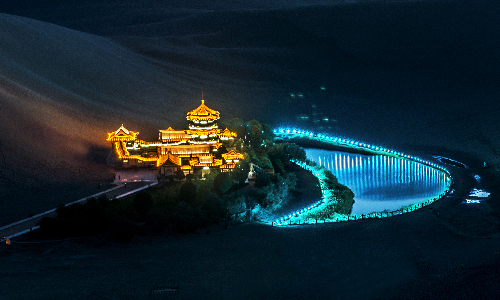
 Liuyuan
Liuyuan Turpan
Turpan After breakfast, you will visit the Yumen Pass, about 90 kilometers northwest of Dunhuang downtown. It will take about an hour and a half to get there. Yumen Pass was established during the reign of Emperor Wu (141BC-87BC) in the Han Dynasty, covering an area of around 260 square kilometers. The origin of its name, Yumen Pass, is related to the jade (Yumen in Chinese means “jade gate”). Because Nephrite was transported to the center of mainland China through here after the opening of the Silk Road. Here you can visit the Han Dynasty Great Wall, beacon towers, and other ruins spanning thousands of years. Walking into Yumen Pass, you will find lots of workers and visitors in Han Chinese clothing (a type of costume worn by the people of Han nationality in the late Ming and early Qing Dynasties).
In the afternoon, we will drive to Liuyuan Railway Station and then take the estimated train D55 16:35/19:56 to Turpan. Turpan is an important town on the ancient Silk Road, with a history of more than 4,000 years. It occupies an area of 69,713 square kilometers with a population of over 690 thousand. Because of the unique climate conditions, Turpan abounds in fruits like grapes and watermelons, known as the “grape city”. Apart from sweet fruits and exotic landscapes, there are many places of interest. For example, you can see the Flaming Mountains mentioned in Journey to the West (one of the Four Great Classical Novels in China, mostly known for the character Monkey King). Therefore, it will be a journey combining food and scenery. Upon your arrival, our guide will be waiting for you at the train station exit and transfer you to the hotel. Please look forward to your journey in Turpan.
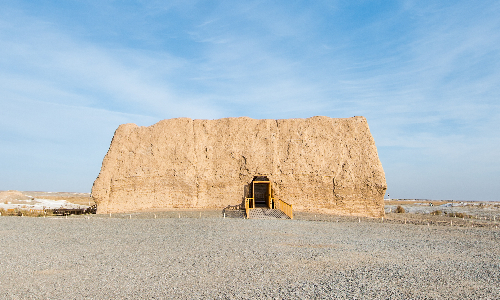
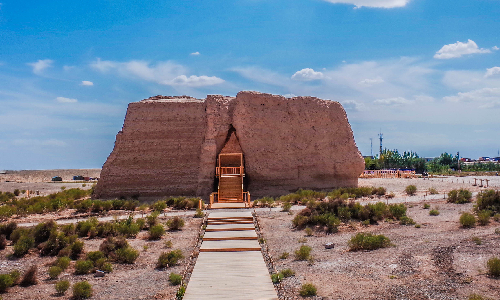
This morning your local guide will take you to visit the Karez Well, around 3 kilometers east of the center of Turpan, and it takes about 10 minutes to reach there. The Karez Well is a special irrigation system in desert areas connected by underground channels and there are about 1,000 Karez Wells in Turpan, nearly 5,000 kilometers long. In Turpan, there is a folk story about the Karez Well and a young shepherd. Legend has it that the shepherd drove his sheep to Turpan to look for lush grassland, only to see a large-scale desert. He wasn’t discouraged and finally found a small depression with thick grass, but there was no water. He was so worried that the sheep would die of thirst and began to dig the grassland for water. When the shepherd dug to a depth of nearly ten feet, a fresh spring appeared. In order to store water, he took advantage of the terrain and designed a system to channel water, which was the rudiment of Karez Wells.
Then your next stop is the Grape Valley, over 9 kilometers northeast of the Karez Well we just took you to and it will take about 20 minutes on the way. The valley stretches about 8 kilometers long and 2 kilometers wide and is known for its grapes. Thirteen varieties of grapes are grown here and seedless white grapes with rich nutrition are even known as “Chinese green pearls”. In Grape Valley, there is a special reception set up for tourists where you can roam under the grapes trellis and taste fresh grapes. In addition, you can see ethnic dining halls, yurts where handicrafts are sold, and places for boating.
In the afternoon, you will drive southwest for about 10 minutes to the Emin Minaret, nearly 5 kilometers away from Grape Valley. Completed in 1778, Emin Minaret, also known as Sugong Pagoda, is the largest one among existing ancient pagodas in Xinjiang. It is 44 meters in height and there is a 72-step spiral stair leading to the top. You can see 15 geometric patterns like triangle and rhombus on the surface of it which are the characteristics of Islamic architecture and 14 windows in different directions of it. Our tour today is over and you will have a rest in the hotel of Turpan tonight.
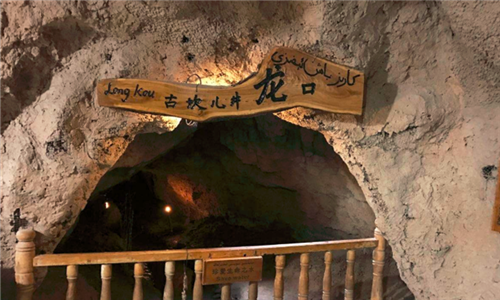
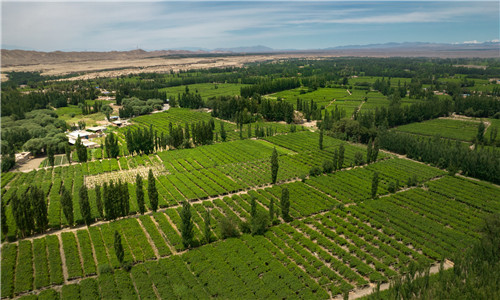
This morning, we will drive for about 15 minutes to the Jiaohe Ruins, over 8 kilometers west of the center of Turpan. With a total area of 470,000 square meters, Jiaohe Ruins is about 1750 meters in length and 300 meters in width. It’s a mysterious kingdom established more than 2,000 years ago. The Jiaohe Ruins mainly consists of three parts: the temple area in the north and the residential areas in the east and the west. According to the research of the archaeologists, there are more than 300 ancient wells that met local people’s water demand in ancient wartime and many of them still have water now.
After leaving the Jiaohe Ruins, you will go to visit the Gaochang Ruins, nearly 50 kilometers southeast of Jiaohe Ruins. It takes over an hour to drive from Jiaohe Ruins to Gaochang Ruins. Gaochang citywas built in the first century and destroyed by war in the 14th century. Now you can see a large number of ruins of religious buildings and palaces here. From the 4th century to the 6th century, with the rise of Buddhism in Turpan, there were many temples built in Gaochang. It’s said that Xuanzang, a monk in the Tang Dynasty (618-907), was once invited into the capital of Gaochang during his journey to the west for seeking Buddhist scriptures. At the king’s sincere request, Xuanzang stayed here for several days and gave lectures. As a Buddhist enthusiast, “a few days” cannot be enough for the King, so he prayed that Xuanzang can stay here forever. However, his great kindness did not shake Xuanzang’s determination to go the west. On the day of departure, King Gaochang personally saw Xuanzang off.
Lunch will be in the local restaurant and then you will visit the Bezeklik Thousand Buddha Caves, 18 kilometers north of Gaochang Ruins. It takes nearly half an hour to reach there. The caves were dug in the 4th century and there were 83 caves originally. Now, there are only 57 caves left. Among them, only 9 caves are open to tourists. Some of them are with murals, and the contents of murals contain Buddhist stories, various images of Buddhas and Bodhisattva, as well as patterns related to music, dance, clothing, and architecture.
Your next stop, the Flaming Mountains, lies in the southwest of the Bezeklik Thousand Buddha Caves and we will drive 15 minutes to get there(about 10 kilometers). The Flaming Mountains, located at the northern edge of Turpan Basin, extends more than 100 kilometers long and 10 kilometers wide at its widest point. In midsummer, the hot air will roll up just like the flames, plus it’s really hot here, so it is called Flaming Mountains. If you had read Journey to the West, you would know something about it. In the book, when Monk Xuanzang and his apprentices pass through the Flaming Mountains, they are blocked by the smothering heat. Under the guidance of a local old man who says that the palm-leaf fan of Princess Iron Fan can cool this place down, Monkey King goes to Princess Iron Fan and tries to borrow that fan of hers. However, she hates Monkey King and refuses his request because he has subdued her son, Red Boy, not long ago. After three attempts, Monkey King finally gets the consent of the princess. He uses the palm-leaf fan to bring down the heat of the Flaming Mountains, and then continues their journey to the west.
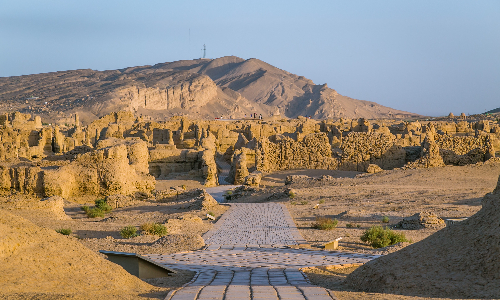
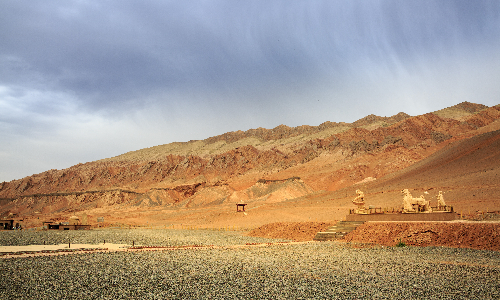
 Urumqi
Urumqi After breakfast, you will take the estimated train Z231 08:31/10:02 to Urumqi, the capital city of Xinjiang Province. It covers an area of 13,800 square kilometers and has a population of over 4 million. Urumqi is a multi-ethnic habitation where you can appreciate unique apparel, horse racing, and ethnic cultural activities.
Your first stop in Urumqi is Heavenly Lake, located in the east of Urumqi. We will drive over 70 kilometers to reach the destination and it takes about one hour. In folklore, it is the fairyland in which the Queen Mother of the West (the Taoism Goddess, in charge of keeping the elixir of immortality, punishment of evil, and warning of calamity) lives. And there is a legend about her: King Mu of the Zhou Dynasty once traveled to the Heavenly Lake and the Queen Mother of the West held a banquet for him. King Mu brought her some precious gifts like silk and jade. He stayed here for several days and fell in love with the Queen Mother of the West. But due to the fact that he was the ruler of a kingdom, he had to leave. At the departure day, King Mu promised to the Queen Mother of the West that he would return after giving the throne to his son. So she waited, and waited, but he never returned. In the end, she turned herself into the Heavenly Lake where King Mu lived to be with him.
After lunch, we will go to the Xinjiang International Grand Bazaar, located southwest of Heavenly Lake. It is over 100 kilometers and takes nearly 2 hours. The Xinjiang International Grand Bazaar is a market that integrates catering, trade, as well as entertainment. Here you can buy all kinds of souvenirs, such as carpets, leather goods, knives, musical instruments, jade, and potteries. There is also a food court with various local snacks, like the roast whole lamp, baked buns, mutton shashlik, hand pilaf, and Nang (Chinese baked pancake).
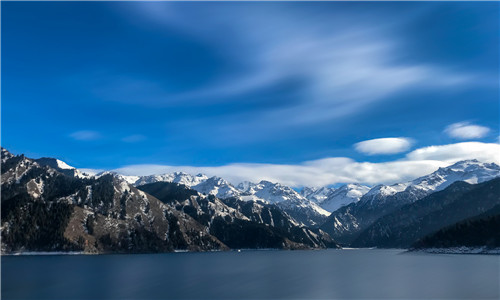
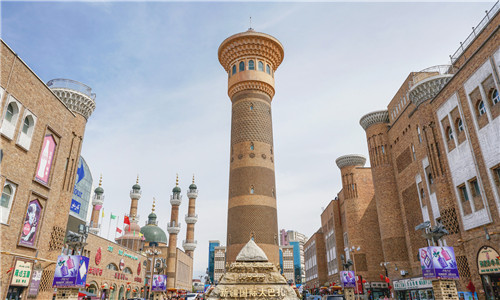
 Beijing
Beijing Today you will take the estimated flight CA1296 10:15/13:55 to Beijing and start your wonderful trip in Beijing. Our guide will meet you at the airport arrival hall and then transfer you to the hotel.
Beijing, the capital of China, covers an area of 16410.54 square kilometers and has a permanent population of more than 21 million according to the statistics in 2020. As a city with a history of over 3,000 years, there are cultural relics and historical sites everywhere and more than 200 tourist attractions are open to the public. I’m sure you have heard about Beijing in the news more than once and now let’s take a close look at it.
After having breakfast in the hotel, we will visit Tian’anmen Square, situated in the center of Beijing. It has an area of 440,000 square meters, stretching 880 meters long and 500 meters wide. Tian’anmen Square was built in 1417 and it’s a place to hold important celebrations and issue decrees to the whole country in the Ming and Qing Dynasties. Arriving at the Tian’anmen Gate Tower, you will see two stone lions in front of the Golden Water Bridge (the bridge across the moat). These two lions have been standing in this place since the Ming Dynasty, and have been there for hundreds of years now. The two stone lions each have a distinct scar on their bodies, and there are various stories about the origin of the scar. The most widespread legend is that the scars were caused by Li Zicheng, the leader of the peasant rebellion in the late Ming Dynasty. In the late Ming Dynasty, the country was plagued by internal and external problems, and was politically corrupt. Although the last emperor of the Ming Empire, Chongzhen, had the intention to reorganize the dynasty and turn the situation around, he did not succeed. When Li Zicheng’s army arrived in the capital, Emperor Chongzhen chose to hang himself. The scars on the stone lions were left at the time when Li Zicheng’s army attacked the Forbidden City. The ruler of the following dynasty did not repair the stone lions’ scars and kept it as it was, as a warning to the future rulers including himself how the previous dynasty had fallen. Besides this site, there are many other interesting places to visit at Tian’anmen Square and our guide will accompany you to explore them.
Then you will continue to visit the Forbidden City (closed each Monday), the imperial palace of the Ming and Qing Dynasties. With an area of 720,000 square meters, it has over 70 palaces and more than 9,000 rooms. In the Forbidden City, you will see the Hall of Central Harmony, completed in 1420, where emperors of the Ming and Qing Dynasties held grand ceremonies such as the enthronement and wedding of the emperor, and the appointment of commander in chief. With an area of 2,377 square meters, it is the largest hall in the Forbidden City. In front of the hall, there is a bronze tortoise and a crane, the symbols of longevity in Chinese culture, and a sundial made of stone which was used to measure time in ancient China. Besides these places mentioned above, many other places in the Forbidden City are worth visiting and you won’t regret coming here.
Then we will continue to visit Jingshan Park. It covers a total area of 23 hectares. Jingshan Park was the imperial garden of the Yuan, Ming, and Qing Dynasties and the emperors often came here for entertainment, banquets, and sightseeing. Located on the highest peak of Jingshan Park, Wanchun Pavilion is the best place to overlook the Forbidden City. You can take a few nice pictures of the Forbidden City and post them on your social media.
After lunch, we will go to the Hutongs near Shichahai area and visit a family there. There are no specific rules for the naming of Hutong. It may be named after plants, places, directions, dialect, and people’s names. With a history of more than 700 years, these mottled red walls and black bricks help you travel back to the old days of Beijing. When you explore the Hutong by rickshaw, you might see the barber cut customers’ hair in the street, residents pass by on bicycles, and a variety of small shops.
Then our guide will take you to the Summer Palace, the imperial garden in the Qing Dynasty. It contains more than 3,000 buildings in different forms and is known as the “Royal Garden Museum”. Here is an introduction to one of these buildings. The Seventeenth-Arch Bridge, built in the reign of Emperor Qianlong (1736-1795), is the largest bridge in the Summer Palace. With a length of 150 meters, it crosses the lake just like a rainbow and the bridge pillars are carved with lions in different poses. This bridge is named Seventeenth-Arch Bridge because it has 17 arches, but why 17? Because if so, no matter from which side you start counting, the 9th arch is always in the middle. It’s related to an ancient belief that the number 9 is a lucky number, and with the 9th one in the middle brings auspiciousness.
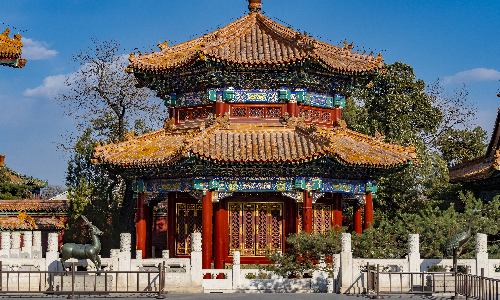
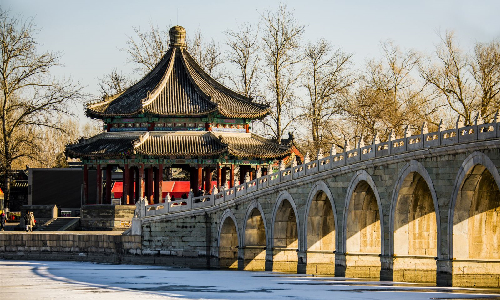
This morning, you will go to the last stop of this tour, Mutianyu Great Wall. It is 73 kilometers away from the center of Beijing and we will drive north for about one hour and a half to get there. Your guide will accompany you and tell you some stories behind it. After arriving, we will take the cable car to the top of the Mutianyu Great Wall. I’d like to introduce you to an interesting place. At the Mutianyu Great Wall, there is a graffiti zone where tourists can write their name and feelings. Importantly, the graffiti wall has been changed into a replaceable one, so that all visitors have the opportunity to create and leave a mark on it.
Leaving the Mutianyu Great Wall, you will be transferred to the airport and board your flight back home. Your 15-day China tour from Hong Kong is coming to an end, and if you have any suggestions, please tell our guide and welcome to contact us. Have a nice journey!
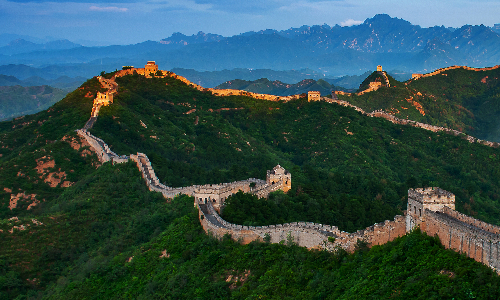
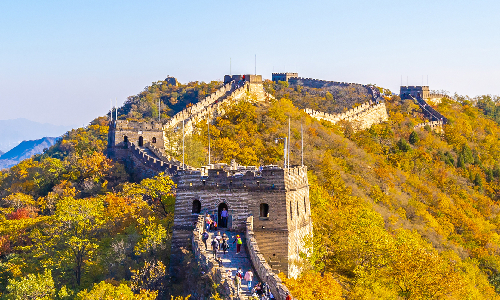
Author: He Simeng
Proofreader: Li Yiwen
| City | Five Star hotel list | Four Star hotel list |
|---|---|---|
| HongKong | Harbour Grand Kowloon | Harbour Plaza North Point Hotel |
| Shenzhen | The Langham, Shenzhen | Hilton Garden Inn Shenzhen World Exhibition & Convention Center |
| Lanzhou | Crowne Plaza Hotel Lanzhou | Lanzhou Lengend Hotel |
| Jiayuguan | Jiayuguan Plaza Holiday Inn | Jiugang Hotel |
| Dunhuang | Wan Sheng International Hotel | Gansu Dunhuang Hotel |
| Turban | Mercure Hotel Turpan Downtown | Jinjiang Metropolo Hotel - Turpan Administration Center |
| Urumqi | Grand Mercure Urumqi Hualing | Tumaris Hotel |
| Beijing | Sunworld Dynasty Hotel Beijing Wangfujing | Sunworld Hotel Wangfujing |
 |
![]() About your child or infant, please contact us for a discounted price.
About your child or infant, please contact us for a discounted price.



We started with a few days in Beijing & ended in Shanghai, from where we visited the Forbidden City and Great Wall. In between we visited Terra Cotta Warriors Museum, Panda Base, Shanghai Disneyland.

We had a wonderful holiday in China which will remain long in the memory. China is a breathtakingly beautiful country full of splendid temples and palaces, mountains and rivers, peaceful rural scenes and bustling shopping streets.
 QUICK ENQUIRY
QUICK ENQUIRY